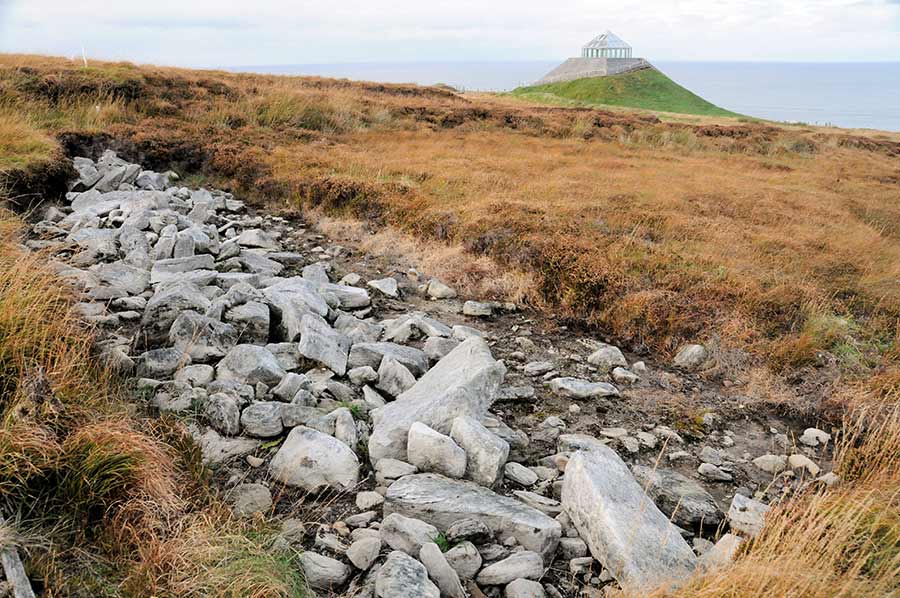
Céide Fields date back to early Neolithic c. 6,000 years ago, say NUI Galway researchers
New research carried out by the Palaeoenvironmental Research Unit at NUI Galway has proven that Céide Fields, situated on the north Mayo coast, date back to the early Neolithic (earliest farming period), almost 6,000 years ago. Céide Fields is one of the best preserved ancient farming landscapes not only in Ireland but in Europe, thanks to the extensive growth of blanket bog that covered and preserved these landscapes.
The research was carried out by NUI Galway’s Professor Michael O’Connell, Dr Karen Molloy and Dr Eneda Jennings, and was recently published in the international journal E&G Quaternary Science Journal.
Widely regarded as dating to the Neolithic, i.e. 4000BC to 2400BC, and hence of great cultural importance, the Céide Fields have been the subject of detailed study by archaeologists and other researchers for well over half a century. The dating of the stone-wall field systems to the Neolithic relies on evidence derived from, inter alia, archaeological surveys and excavations, pollen analysis, study of bog-pine timbers, i.e. bog deal, and radiocarbon dating.

Professor Michael O’Connell, Professor Emeritus at NUI Galway, said: “This new research not only confirms the early Neolithic age of the field systems but also leaves no doubt as to the intensity of the initial phase of Neolithic farming in north Mayo. This started at 3800BC and lasted for 400 years. Not only was it of long duration, but the fossil pollen data, provided by pollen analyst Dr Karen Molloy, at NUI Galway, suggests that it was more intensive than any farming of Neolithic age so far recorded in Ireland or Britain.”
Field walls
The research shows that, in all likelihood, construction of the regular system of field walls at Céide Fields took place during the earlier part of the intensive farming phase during the early Neolithic. The fossil pollen evidence, taken in conjunction with the large, indicates that the farming was mainly pastoral, more than likely a cattle-based farming economy. Cereal cultivation, however, also took place and was, undoubtedly, an integral part of the local farming economy. The intensive, early Neolithic farming phase was followed by a period of three centuries with reduced, though still substantial farming. After that, there was a lull in farming that lasted several centuries. It was during this lull, in the late Neolithic and prior to the onset of the Bronze Age, that major expansion of blanket bog occurred. Blanket bog, today a dominant landscape feature in north-west Mayo, is sometimes referred to as ‘climatic peat’ because of its requirement for high and frequent rainfall.
The NUI Galway researchers show that a shift towards wetter and cooler climate, in itself, does not provide a satisfactory explanation for the way in which Neolithic farming waxed and waned at Céide Fields. Other factors that were possibly involved include deforestation, soil acidification, and impoverishment though prolonged use with little or no replenishment of essential nutrients. However, abandonment of farming, in the context of a considerable population decline triggered by cultural and socio-economic factors, was probably more important than any fluctuations in climate.
The phenomenon of pine growing within blanket-bog contexts, a frequent occurrence in the past, is also discussed at length by the researchers in the light of the many radiocarbon dates now available from fossil pine timbers preserved by bog, not only at Céide Fields but also elsewhere in Co. Mayo, including Erris, Garrynagran and Shanvallycahill. The new information, which relies mainly on research carried out by Dr Eneda Jennings at NUI Galway, sheds additional light on landscape development and climate change during prehistory in western Ireland.

Professor O’Connell continued: “The substantial and multi-disciplinary body of evidence now available demonstrates, beyond all reasonable doubt, that the pre-bog field system at Céide Fields pertains to the Neolithic and indeed the earlier part of the Neolithic as known from Ireland, Britain and much of north-western Europe including Scandinavia, a view that is also shared by most archaeologists and other palaeoecologists.”
The full study is available (open access) at https://www.eg-quaternary-sci-
